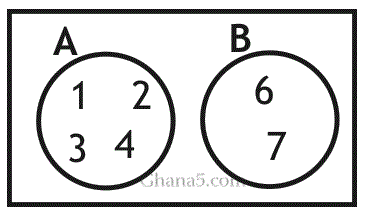1. Which of the following is not a prime number?
A. 3
B. 5
C. 7
D. 9
Answer: D
Notes: A prime number can be divided (evenly) only by itself and 1. For example, 5 is a prime number because it can be divided only by itself and 1.
2, 3, 7, 11 and 13 are also prime numbers.
2. What property of arithmetic operation is illustrated by n(q + v) = nq + nv ?
A. Addition
B. Associative
C. Commutative
D. Distributive
Answer: D
3. Which of the following describes the relationship between the sets A and B in the Venn diagram below?

A. A⊂B
B. A∩B = 5
C. A∩B = Ø
D. A∪B = {1, 2, 3, 4, 5, 6, 7}
Answer: C
Notes: A and B are disjoint sets – they don’t have any members in common i.e. none of the members of set A belong to set B. The same is the case the other way round: none of the members of set B belong to set A.
The following data show the marks of students in a test: 10, 4, 1, 4, 3, 3, 2, 1, 1, 7, 8
Use the information to answer the next two questions (4 and 5)
4. If the pass mark is 4, find the number of students who scored more than the pass mark.
A. 1
B. 2
C. 3
D. 4
Answer: C
5. Find the mean mark.
| Marks (x) | Frequency (f) | fx |
| 1 | 3 | 3 |
| 2 | 1 | 2 |
| 3 | 2 | 6 |
| 4 | 2 | 8 |
| 7 | 1 | 7 |
| 8 | 1 | 8 |
| 10 | 1 | 10 |
| ∑ f = 11 | ∑ fx = 44 |
Mean = 
6. Simplify 159 ÷ 157
A. 30
B. 63
C. 225
D. 240
According to one of the Laws of Indices or Exponents or Powers, since the base numbers are the same and we are being told to divide, we'll just have to take away the second exponent (or power) from the first.
159 ÷ 157
= 159−7
= 152
= 15 × 15
= 225

Can we have some more of the questions?
Please don’t show the answers